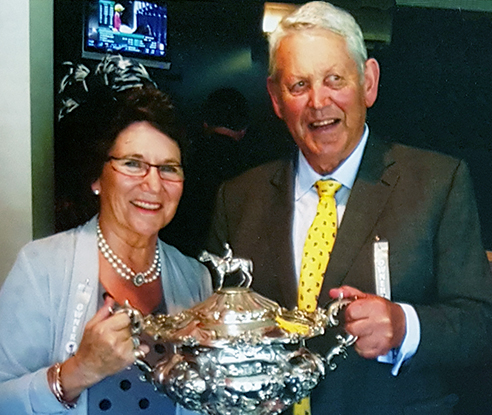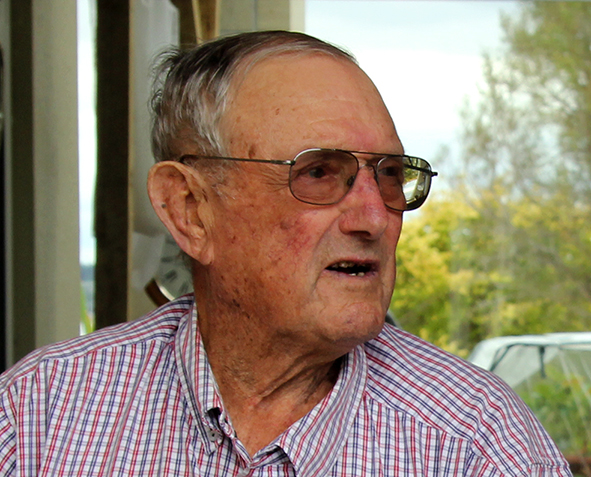Nick Wigley and Victoria Woodley at Riccarton last Saturday. RIGHT: Phar Lap’s close relative Monte Carlo wins the 1956 Victoria Derby for Nick’s grandfather owner-breeder Ken Austin
by Brian de Lore
Published 31st July 2020
The grandfathers of both Nick Wigley and Victoria Woodley between them made two purchases between 80 and 90 years ago that determined the destiny of the family of Phar Lap and set the scene for the future success of Inglewood Stud in North Canterbury.
Nick Wigley and Victoria Woodley are both long-time members of the Canterbury Jockey Club and, for many years, knew one another by sight only, but had never had a formal introduction. Both were oblivious to the fact that their respective grandfathers were well-known to each other, and one would sell to the other a mare in 1939 that would bring to the fore the vision and genius of Ken Austin.
Last Saturday at Riccarton, they met for the first time, via an introduction through The Optimist, and traded notes on their respective grandfathers who, between the two of them all those years ago, controlled most of the family of the immortal Phar Lap.
Nick had only minutes previously as an owner-trainer won the two-year-old event with his impressive debut runner Matchmaker, a daughter of Makfi and the Australian bred mare Somebody, by Fastnet Rock.
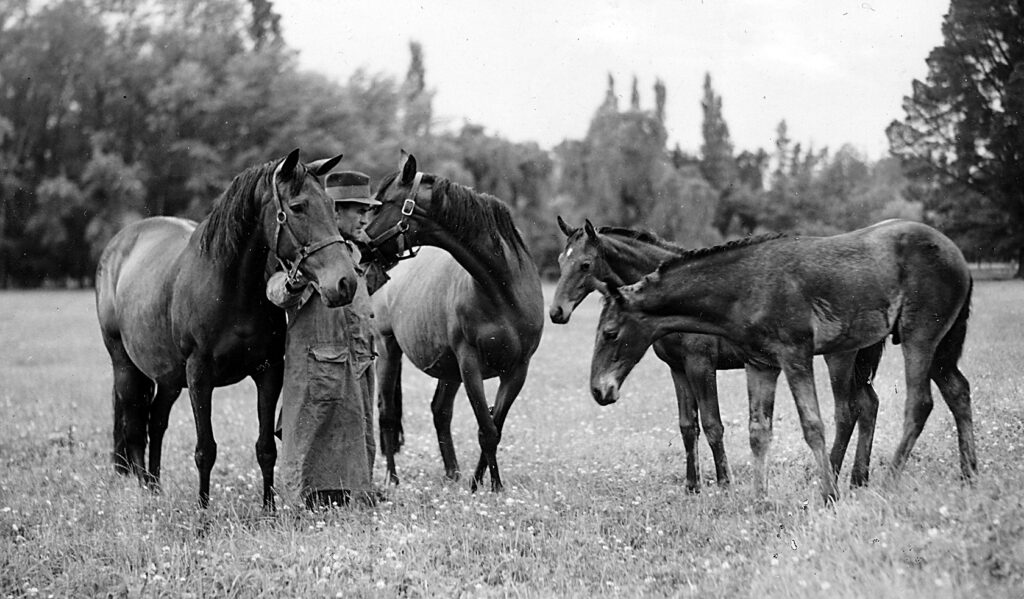
And just as a by-the-way, some of the occurrences revealed in this story won’t be found in any of the books on Phar Lap and are only available here as a result of hours of research in studying the Wigley family records of Ken Austin and searching meticulously through old newspaper archives.
Victoria’s grandfather was highly successful Christchurch businessman Fred Armstrong who owned two large draper-milliner stores that traded as T.J Armstrong & Company. In 1932, he decided to enter into the horse breeding business with a purchase at the Kaituna Stud dispersal sale – held eight days after Phar Lap had won his final race in the USA at Agua Caliente.
Phar Lap’s breeder A.F (Alick) Roberts had died in August of 1931, and the sale held at Addington showgrounds was a dispersal of all his Kaituna Stud stock, which included Phar Lap’s sire Night Raid and his dam Entreaty.
Although Phar Lap was by now world-famous, the sale took place at the height of the Great Depression and was so soon after the Agua Caliente success, prices reflected the times and disappointed the trustees of the estate. The local Press reported that “over 500 attended and while the bidding generally was brisk, prices were low.”
Phar Lap’s then 13-year-old sire Night Raid was passed-in at 2,500 guineas and his dam, Entreaty, two years younger at 11, sold to Fred Armstrong for 1,500 guineas – the buyer making his first-ever thoroughbred purchase. The Press reported that Armstrong had often expressed his wish to own a thoroughbred, and anticipating a depressed market, he instructed Riccarton trainer Fred Jones to go up to 1,500 guineas for Entreaty – she had a colt foal full-brother to Phar Lap at foot and was in-foal to Night Raid again.
It was an inspired purchase. The 1,500 guineas Armstrong paid, converted on the CPI government Reserve Bank calculator has a 2020 value of $182,000. It was the time of the Great Depression, a domestic market only and, therefore, cannot be compared to today’s globalised market prices for mares, which regularly sees $1 million sales and up to $4.2 million in the case of Sunlight earlier this week.
Eight days after the Kaituna Stud dispersal sale on April 5th, Phar Lap was dead from arsenic poising, which made headlines in racing pages around the world and, if anything, substantially increased the value of the Entreaty three-in-one broodmare package.
Fred Armstrong was a businessman more than a breeder. He had a small property Riccarton property at 106 Waimari Road on which he kept horses, including family ponies, and on which he would later build-up his small band of mares – Mick Murfitt was the groom looking after all the horses.
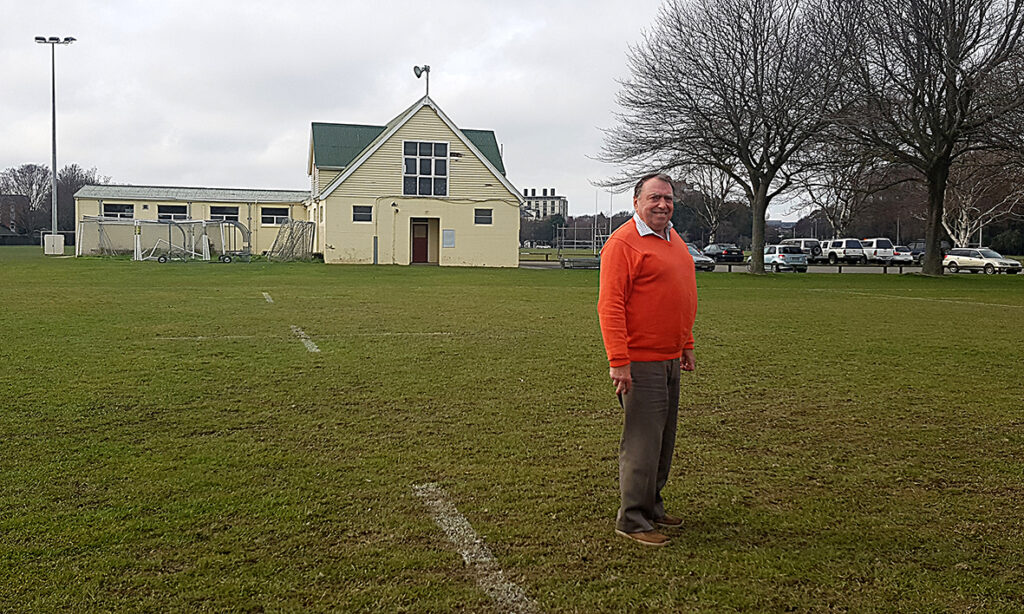
The stables on the property are still standing today, converted into a sports pavillion, and the property is now the Ilam playing fields used by the University Rugby Club and cricket in the summer. The unmarked burial plot of Entreaty lies near the 10-metre line on the rugby field adjacent to the old stable block.
The Alick Roberts Kaituna Stud dispersal sale was also significant in that Night Raid was passed-in for 2,500 guineas. It opened the door for Nick Wigley’s grandfather, Ken Austin, to negotiate a standing arrangement for the stallion to take-up residence at Elderslie Stud near Oamaru. In 1931 Ken Austin moved to the stud from Australia to take over full management and was subsequently instrumental in turning Elderslie into the most successful stud in the country.
Entreaty’s new owner was also to send his black mare back to Night Raid to consummate their ninth union in nine years, but after foaling a filly full-sister to Phar Lap (later named Te Uira) she would miss getting in-foal for only the second time. Entreaty would stay on at Elderslie for a tenth consecutive mating to Night Raid, which in 1934 produced a filly foal named Raphis. This filly would become the foundation mare upon which Ken Austin would pivot Inglewood Stud’s future success.
Raphis didn’t go to the yearling sales or get to the races after sustaining an injury at two years. Fred Armstrong bred her as a three-year-old to the stallion Man’s Pal, but she failed to conceive, and when she also missed to the same sire in the 1938 season, he decided to quit Raphis at a Christchurch Easter Bloodstock Sale along with her two-year-old half-brother named Ilam Way (by Iliad) and Entreaty herself.
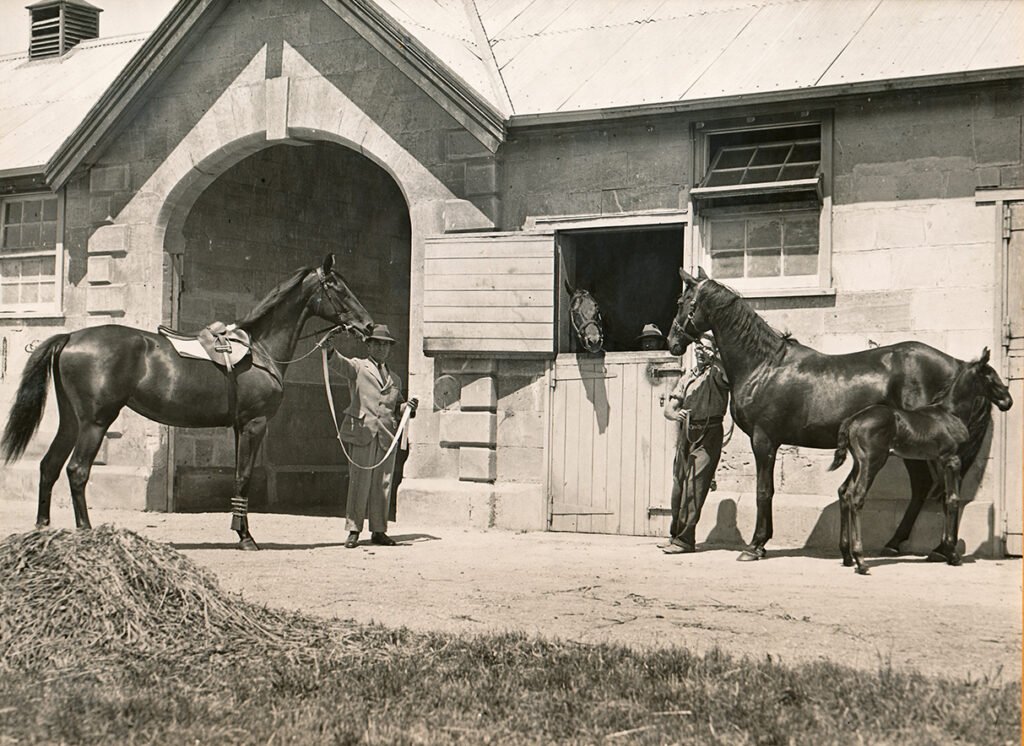
World War II was only six months old, and the sale low-key as a result. Ilam Way made only 25 guineas, Entreaty (empty for two years and now 18 years old) was passed-in at 100 guineas, and Phar Lap’s four-year-old full-sister Raphis went to Ken Austin’s winning bid of 40 guineas. It was a bargain buy that would ultimately bring years of continued success for Inglewood Stud.
Ken Austin was a man of many talents, and getting barren mares in foal was one of them. Once he had her ready, she went in-foal to the first service by the Elderslie Stud stallion, Solicitor General, and the mare would conceive to Battle Song in each of the next three years, as well.
Her first-foal was the top performer in CJC Champagne Stakes winner John o’ London, the winner of nine races. Unfortunately, she slipped the next year, but the third foal, retained for racing by Austin, was the 1946 Great Northern Oaks winner Swingalong – also second in the New Zealand Oaks.
Ken Austin turned down a big offer from America in favour of winning nine races with John o’ London. But the best Raphis produce was her fourth foal, Count Cyrano (by Battle Song). As a four-year-old, he brilliantly won the1949 AJC Metropolitan Handicap as the 4/1 favourite, making up 12 lengths in the last half-mile, and was installed a hot favourite for the Melbourne Cup. Randwick trainer Frank Dalton considered Count Cyrano a certainty to win the Cup, but tragically, having his final gallop for the big race, he was killed in a devastating track accident when he collided with two horses coming through the gap onto the track in Melbourne.
The foal after Count Cyrano was the Lord Bobs filly, Bobalong, which would win at Randwick before a breeding career at Inglewood that in successive years produced the top performers in Monte Carlo and Del Monte – both sired by the ill-fated half-brother to Royal Charger in Lucky Bag.

In the ownership of Ken Austin and trained by Frank Dalton, Monte Carlo won both the 1956 AJC and Victoria Derbies. All told, he won 13 races including the AJC Metropolitan and VRC Mackinnon Stakes but in the 1958 Melbourne Cup, Monte Carlo finished an unlucky second to Baystone after striking interference in what was recognised as a roughly run Cup. He later sold Monte Carlo to the USA for a reputed 15,000 guineas.
Ken Austin could easily have had two Melbourne Cups on the mantlepiece, nine years apart, but it wasn’t to be. Where luck and judgement did come to him, however, was through Raphis and all her daughters, which he retained, raced and bred from at Inglewood Stud.
Within ten years of purchasing Raphis, Inglewood Stud was churning out more winners than any other stud in the country. More importantly, Ken Austin went from leasing Inglewood to owning it freehold with the financial flexibility to expand his breeding empire.
Raphis daughters Swingalong, Bobalong, Raphina and Deposit all met with a share of success in the broodmare paddock, helped by judicious Inglewood stallion selections that included Solictor General, Battle Song, Sun King, Lucky Bag, Defaulter and Messmate.

The Raphis legacy lives on today through horses such as the recent four-times group one winner in Trapeze Artist. And the way this branch of the Raphis family found its way to Australia was through the Inglewood Stud dispersal sale in February 1960 following the death of Ken Austin the previous December.
The sale topper was expected to be the stallion Messmate which Ken Austin would saddle and ride regularly right up to the time of his sudden death at the stud at the age of 78. Jack Lindsay of Balcarres Stud bought Messmate for 4,000 guineas to replace Count Rendered.
However, the top price was 4,100 guineas paid by Mr R. Bowcock of Alabama Stud, Scone, was for Monte Carlo’s sister and Bobalong’s five-year-old daughter Del Monte in-foal to Messmate with a filly at foot by Castle Donnington. Back in the Hunter Valley’s Alabama Stud in the spring, Del Monte produced a brown filly named Lilting – the stakes-placed winner of three races and eventually the dam of Golden Slipper winner Fairy Walk and highly successful Star Kingdom sire Planet Kingdom.
She is also grandam of three times group one winner Cheyne Walk while Deposit, which also found its way to Australia, is the second dam of AJC Doncaster Handicap winner Authentic Heir.
The success achieved by the descendants of Entreaty is extraordinary but far too extensive to list here. It’s fair to say that the late Ken Austin at Inglewood Stud made the most of his opportunity with Raphis, and although much less famous, Raphis was to Ken Austin what Eulogy was to George Curry.
Inglewood Stud was producing more winners than any other stud in New Zealand within a decade of starting and in the 1954-55 season also topped the prizemoney list. It didn’t happen by accident.
The sale of Raphis to Ken Austin in 1939 for only 40 guineas was Fred Armstrong’s loss, but no one could have managed the mare better and drawn so much success as Ken Austin did. The ownership of Raphis wasn’t the only transaction that took place between the two grandfathers of Nick Wigley and Victoria Woodley, and Fred Armstrong was well ahead financially on the Entreaty purchase within a couple of years of making his investment.
In late 1934, Hailey’s Bloodstock Agency, on behalf of an English stud farm, inquired about the possibility of purchasing a relative of Phar Lap. Acting for Fred Armstrong, Ken Austin negotiated the sale of Te Uira, the then unraced two-year-old full sister to Phar Lap, for the sum of 2,000 guineas – 500 guineas more than he had paid for the three-in-one package when Te Uira was in-utero.
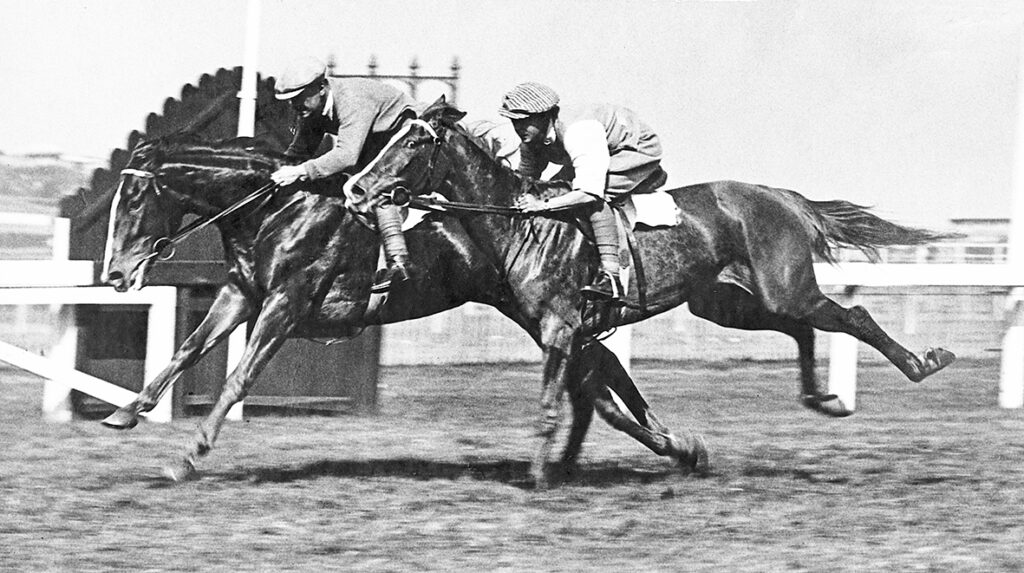
Fred Armstrong also rejected several offers for Entreaty, including a proposal to breed to Night Raid to English time. The offer was for the 1935 season when the mare was rising 15-years and hadn’t been bred the previous spring after foaling Raphis.
The newspaper report of the day said that Fred Armstrong would agree for a fixed-price for a living foal irrespective of its condition or conformation. It also stated that “Mr Armstrong considered he was justified in asking a good figure.”
But when the letter came back from England it rejected the proposal owing to the large amount requested.
Ken Austin was undoubtedly one of the most gifted horsemen God ever put breath into. But he was also multi-talented on many fronts – an extraordinary horseman both as a rider and blessed with his own version of ‘horse whispering’ – able to do anything with any horse. His full story could only be done justice in a book, and this blog is merely a snapshot of what he achieved.
He was also an accomplished auctioneer, polo player, artist, bloodstock agent, administrator, studmaster, and commanded so much respect he literally ‘walked with kings.’
In 1920 he was officially entrusted with the task of finding suitable mounts for the Prince of Wales (aged 26), Lord Louis Mountbatten and Admiral Halsey when they visited Sydney on the battleship H.M.S. Renown, and he and the Prince (Edward VIII who was then heir to the throne but abdicated in 1936) rode a full track gallop on the course proper at Randwick.
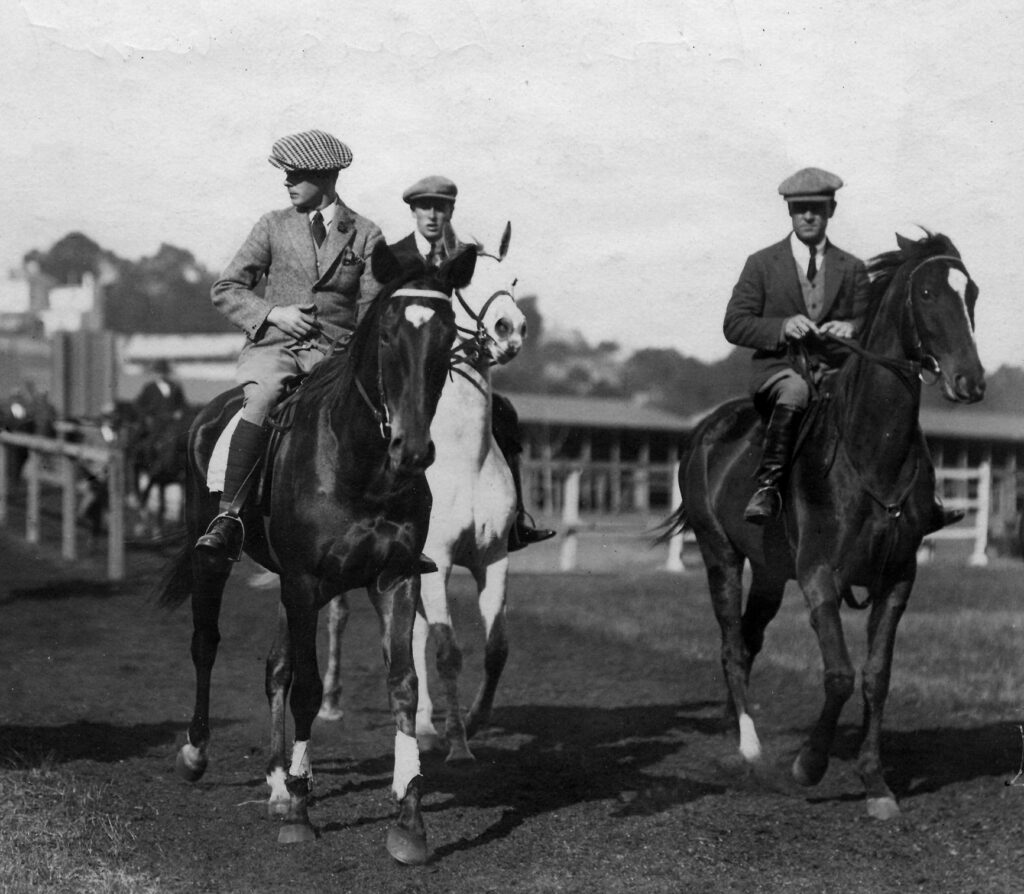
The New Zealand-Ken Austin connection started in 1916 when he received in Sydney a letter from Canterbury owner George Greenwood requesting he inspect the Melton Stud yearlings at the Melbourne sales and select a colt that would be value-for-money. Together with his boss, H. Chisholm, they conducted the inspection and purchased for 230 guineas a colt by The Welkin from Light, which would be sent to New Zealand and later named Gloaming – the winner of 57 of his 67 starts.
In 1946, Ken Austin, along with J.G Alexander of Cranleigh Stud, Alister Williams of Te Parae, and T.C. Lowry of Okawa founded the New Zealand Thoroughbred Breeders Association – Ken Austin was elected its first president. His list of achievements is extensive.
Today, Inglewood Stud operates under the astute management of Ken Austin’s great-grandson, Gus Wigley. There is a noticeable spring in Gus’s step as he looks optimistically forward to the first yearlings of War Decree and runners in 2021-22 season, and continuing the tradition and standards set on this historic property by his highly esteemed forefather.
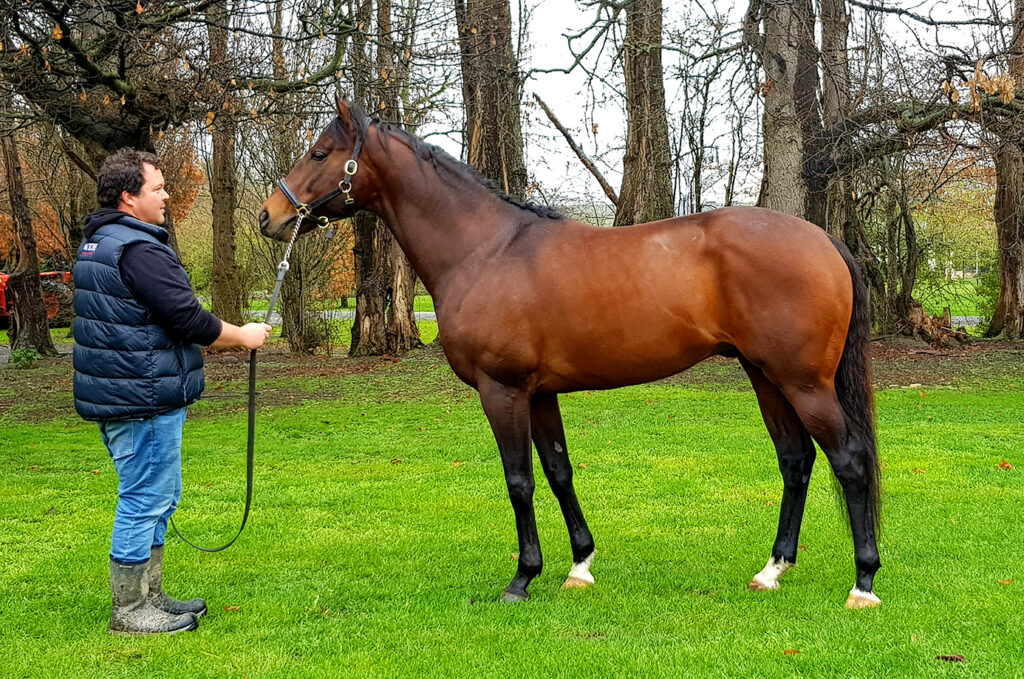
by Brian de Lore


